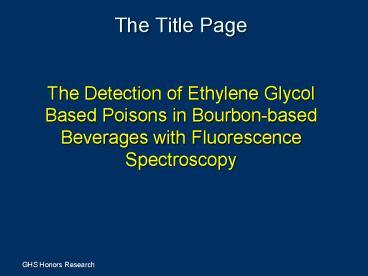The Title Page - PowerPoint PPT Presentation
1 / 14
Title:
The Title Page
Description:
These PAH's & Antifreeze emissions occur at different wavelengths ... Litten, S., Babish, J., Pastel, M., & Werner, M. Relationship between ... – PowerPoint PPT presentation
Number of Views:21
Avg rating:3.0/5.0
Title: The Title Page
1
The Title Page
The Detection of Ethylene Glycol Based Poisons in
Bourbon-based Beverages with Fluorescence
Spectroscopy
2
The Purpose
The purpose of the research is to detect the
presence, and the concentration of Ethylene
Glycol Based Poisons in Bourbon-based Beverages
using Fluorescence Spectroscopy
3
Your Hypothesis
- Poly Aromatic Hydrocarbons (PAHs) within
Bourbon, as well as common commercial sources of
Ethylene Glycol (Antifreeze) exhibit Fluorescent
emissions.These PAHs Antifreeze emissions
occur at different wavelengthsFluorescence
spectroscopy can be used to detect the presence
and concentration of Ethylene Glycol (Antifreeze)
in Bourbon beverages
4
Your Procedural Plan
- Most bourbons are Aged Inside of Charred, burned
Oak Barrels - Burned Oak contains PolyAromatic Hydrocarbons
(PAHs). These PAHs are transferred to the
bourbon during Aging. - The Color and Flavor of Bourbon are derived from
this Burned Oak Aging. - Trace amounts of these PAHs are dissolved in the
bourbon these PAHs fluoresce in the Visible
Region at 480 nm.
5
Your Procedural Plan
- Antifreeze contains approximately 95 of Ethylene
Glycol, which is the compound that is responsible
for the cooling properties. - Antifreeze also contains Fluorescein, which is
the Aromatic Compound that provides the
well-known Bright Green Color at 520 nm.
Fluorescein is added so that a technician can
easily diagnose a leak within the engines
cooling system.
6
Your Procedural Plan
- If ingested by Humans, Ethylene Glycol, while not
immediately toxic, is metabolized within the body
to Glycoaldehyde, and later metabolized to
Glycolic Acid, Glyoxylic acid, and Oxalic Acid. - These three toxic metabolites cause Central
Nervous System (CNS) Depression (i.e. drowsiness,
and respiratory failure), followed by
Cardiopulmonary Disorder, and later Renal Damage. - The Lethal Dose of Ethylene Glycol, for an adult
human, is 10 milliliters.
7
Your Procedural Plan
- Fluorescence spectroscopy can be used to identify
PAHs in Bourbon, which fluorescence at 470 nm. - Ethylene glycol is most typically found in
Antifreeze. Fluorescence Spectroscopy can be
used to detect the typical green fluorescence,
most commonly known as Antifreeze Green, with a
fluorescent emission at 520 nm.
8
The LS-50B Fluorescence Spectrometer
9
Data Analysis
Emission Spectrum of Bourbon
10
Emission Spectrum of AntiFreeze
11
Emission Spectrum of Bourbon Drink with Ethylene
Glycol-based Poison
12
Quantitative Results of Ethylene Glycol in
Bourbon Using a Beers Law Regression
13
Results
- Fluorescence spectroscopy can be used to detect
the presence of Antifreeze-based Ethylene Glycol
(EG) Poisons in Bourbon - A Beers Law plot of the Fluorescence Emission
versus ml of Ethylene Glycol-based Poison can be
used to detect the concentration of the ethylene
glycol in a bourbon beverage - Our analysis resulted in a EG concentration of 29
ml, which exceeds the lethal dose of 10 ml.
14
References
- Litten, S., Babish, J., Pastel, M., Werner, M.
Relationship between fluorescence of polynuclear
aromatic hydrocarbons in complex environmental
mixtures and sample mutagenicity. Bulletin of
Environmental Contamination and Toxicology, May,
2005. Vol. 28, Issue 2, p. 141, 8p, (ISSN
0007-4861), Database SpringerLink. - Cording, M. Swinson, J. Assertive discipline
in a school for pupils with emotional and
behavioral difficulties. British Journal of
Special Education, June 2002. Vol. 29, Issue 2,
p.72, 3p, (AN 6721010), Database Academic
Research Premier. - The Determination of Polycyclic Aromatic
Hydrocarbons (PAH) in a Surface Soil Sample from
Bamberton Cement Plant by High Pressure Liquid
Chromatography. Retrieved October 20, 2006 from
http//www.geocities.com/waterose_test/labs08b.htm
l































